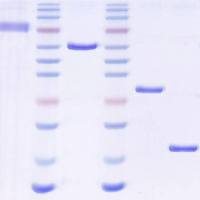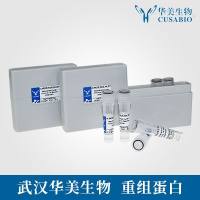A Method for StructureActivity Analysis of Quorum-Sensing Signaling Peptides from Naturally Transformable Streptococci
互联网
Many CSPs from naturally transformable streptococci have been identified and their activity for genetic competence has been validated (2 �4 ). These signaling molecules are small, unmodified peptides, ranging from 14 to 25 residues in length, and induce powerful strain-specific activity at nano-molar concentrations. Some CSPs have been chemically synthesized and used as a tool to induce genetic competence during molecular cloning. Recently, the structure�activity relationships of CSPs from both S. pneumoniae and S. mutans have been analyzed (9 , 10 ). The CSPs from these organisms have been found to adopt an amphipathic, α-helical conformation with a defined hydrophobic face that contributes to the CSP specificity. Furthermore, the CSP from S. mutans reveals two functional domains (10 ). The C-terminal structural motif consisting of a sequence of polar hydrophobic charged residues is crucial for activating the signal transduction pathway, while the core α-helical structure extending from residue 5 through to the end of the peptide is required for receptor binding. Sequence alignment of CSPs from various streptococci shows that almost all CSPs have such a motif at the C-termini (10 ), suggesting that these CSPs likely have similar functional domains. However, CSP variants have been identified in many species and each induces competence in a highly strain-specific manner. Thus, the CSP variants may provide an excellent model to study peptide�receptor interactions in these bacteria. Here, we extend our technical information and describe methods and protocols for structure�activity analysis of CSP from S. mutans by combining activity assays with nuclear magnetic resonance (NMR) and circular dichroism (CD) spectroscopies (see Appendix ). The methods described herein may provide a platform and rationale for analyzing CSPs from other naturally transformable streptococci.
Efficient structural characterization of signaling peptides by CD and NMR requires purified (≥95% purity) and soluble peptides. In our study, all the peptides were commercially synthesized and purified by reversed-phase high-pressure liquid chromatography. Their identity was confirmed by a mass spectrometry (10 ). The peptides were lyophilized and stored at �20°C until use. For CD and NMR studies, each peptide was dissolved in an appropriate solvent. For activity assays, each peptide was freshly dissolved in sterile distilled water at a concentration of 1.0 mM (stock solution), which was further diluted as required.
The first step was to optimize sample conditions by adjusting pH, ionic strength, and temperature to mimic physiological conditions with the constraint in which the conditions were compatible with data acquisition (11 ). For CD spectroscopy, peptide concentrations were typically on the order of 50 µM with 200 µL of solution (12 ). Buffers, co-solvents, and additives (e.g., detergent molecules) were non-chiral, sodium-free, and non-absorbing within the wavelength range (typically 250�180 nm). For NMR studies, buffers, co-solvents, and additives were hydrogen-free or deuterated. Samples could be dissolved in as little as 10 µL, but typically, spectrometers were designed for sample volumes of at least 500 µL. Due to the inherently low sensitivity, concentrations of peptides ranged from 1.0 to 10 mM (13 ).
In our study, synthetic peptides CSP (UA159sp) and TPC3 for CD and NMR were dissolved in 95/5/0%, 70/0/30%, 30/0/70%, or 0/0/100% aqueous buffer/D2 O/TFE-d 2 , or 95/5 aqueous buffer/D2 O with 300 mM DPC-d 38 (98 atom %D), where TFE refers to trifluoroethanol and DPC-d 38 refers to perdeuterated dodecylphosphocholine (10 , 13 ). The aqueous buffer used for sample preparation contained 50 mM K2 HPO4 /KH2 PO4 at pH 7.0. The concentration of peptides for solutions containing 100% TFE-d 2 or DPC-d 38 was 2 and 5 mM. For diffusion studies, we analyzed the solutions containing peptides and DPC-d 38 by lyophilizing and dissolving them in an equivalent volume of D2 O (99.9 atom %D) followed by transferring into a 5 mm OD, D2 O magnetic susceptibility-matched NMR tube (BMS-3; Shigemi, Tokyo). The sample height of 1.2 cm ensured that the entire sample was within the radio frequency coils, which was essential for artifact-free and accurate diffusion measurements.
CD spectra for peptides and reference solutions were recorded at 298 K on a Jasco J-920 CD spectrometer with a 1-mm quartz cuvette. Spectra were collected and averaged over 16 scans from wavelengths 190 to 250 nm with a 0.1-nm step resolution. CD measurements were performed and analyzed to confirm the effects of TFE on the secondary structure of the peptides (14 , 15 ). In our study, we analyzed the peptides by using CD analysis package DICHROWEB (www.cryst.bbk.ac.uk/cdweb/html) (16 ).
From the NMR-derived structural constraints, two series of structural calculations were performed with or without added hydrogen bonds to assess the effect of adding suspected hydrogen bonds into the structure calculation. All structural calculations were based on previous studies using the XPLOR 3.1 software package (10 ). Final calculated structures were energy minimized with 2,000 conjugate gradient steps before processing to the restrained annealing molecular dynamics calculation. A total of 33 and 21 UA159sp and 43 and 36 TPC3 (with and without hydrogen bonds included within the simulation) lowest energy structures were retained that had no violations of NOESY constraints >0.5 Å (18 ). The overall quality of these refined structures was examined with the program PROCHECK (19 ). Except for random coil sections, all backbone dihedral angles resided in the well-defined, acceptable regions of the Ramachandran plot. Three-dimensional structures of UA159sp and TCP3 determined from NMR were constructed by computer simulation using the VMD software (http://www.ks.uiuc.edu/Development).
To assay quorum sensing (QS) activation in response to addition of a peptide without interference by endogenous CSP from a wild-type strain, a comC mutant that was unable to produce, but still responded to CSP was constructed in S. mutans GS5 using the strategy as described previously (20 ). Following genetic recombination via allelic exchange, the comC deletion mutant was created by insertion of a spectinomycin (Specr ) resistance cassette (21 ) into the comC gene of strain GS5. The mutant was then confirmed by polymerase chain reaction (PCR) and sequencing of the junction site of the Spec cassette as described previously (20 ). The resulting mutant was named SMdC and was used as a negative background strain of signaling peptide (CSP) for CSP-dependent assays of genetic competence, lacZ reporter, and bacteriocin production.
To assay QS activation in response to addition of a peptide, we constructed two types of lacZ transcriptional reporter strains that represented two levels of QS-activated gene expression. The first was a lacZ reporter gene fused to the comDE promoter, which allowed monitoring of the activity of the comDE promoter in response to a test peptide. The second strain was a lacZ reporter gene fused to the promoter of nlmAB , the gene encoding a nonlantibiotic bacteriocin and its expression directly controlled by the ComE (6 , 22 ). This strain allowed assay of comDE -controlled bacteriocin production.
For the first reporter strain, we simply transformed previously constructed vector pYH2 (10 ) into the comC mutant (SMdC) to generate SMdC-pYH2 (PcomDE::lacZ , comC − , Specr , Kanr ). pYH2 was constructed in such a way that the comDE promoter was fused to a promoterless lacZ gene on the backbone of Streptococcus�Escherichia coli shuttle vector pSL. The vector pSL was also transformed into the same mutant SMdC and used as a background control (SMdC-pSL). These strains were then assessed for lacZ reporter activity in response to addition of peptides.
For the second reporter strain, we generated a chromosomal nlmAB�lacZ fusion strain by transforming a PnlmAB::lacZ fusion construct pOMZ47 (6 ) into both comC mutant SMdC and wild-type GS5. The resulting reporter strains were confirmed by PCR and sequencing of the fusion sites as described previously (6 ). The confirmed reporter strains were respectively named SMdC-PnlmAB (PnlmAB::lacZ , comC − , Kanr , Specr ) and SMGS5-PnlmAB (PnlmAB::lacZ , Kanr ). The strain SMGS5-PnlmAB was used a positive control.
[1] [2] [3] 下一页









